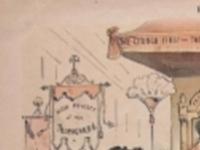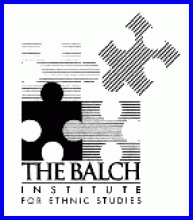This lesson presents students with a number of cartoons representing different stereotypes held against Irish immigrants in the late-nineteenth century. Throughout the lesson, students will interpret the meanings of these cartoons and analyze how they both reflected and shaped the general population's view of Irish immigrants.
Reading Anti-Immigrant Images
Reading Anti-Immigrant Images
Essential Questions
Objectives
Students will be able to:
• Understand the factors that led to anti-immigrant sentiment and nativist activities in the 19th century.
• Analyze images and come to understand the interrelatedness of social, political, economic, racial, and religious aspects of a society.
• Formulate conclusions as to how and why nativist ideologies grew in Pennsylvania in the early 19th century.
• Present a comprehensive work displaying their understanding of the 1844 Riots in Pennsylvania.
Other Materials
Primary Sources from MSU Appel Collection
Suggested Instructional Procedures
1. Begin with a short lecture about Nativism. Explain that the attitudes expressed in the texts represent the attitudes of some mainstream Americans in the 1840s, such as Samuel Morse. Some Americans reacted to Irish and/or Catholic immigrants negatively, and these attitudes increased throughout the early 19th century. Discuss how these issues relate to some of the conditions of the period and emphasize that those conditions made people uncomfortable with the Irish’s racial and religious difference. Some of these conditions were:
- Social: rapid social change, increasing immigration, greater mobility of the population, many people moving from the countryside to the city
- Economic: changing structure of the economy from skilled labor to unskilled industrial labor; unemployment and loss of status for skilled worker
- Religious: Protestant majority controlled the country, conflicts over which Bible to teach in the schools; fears of papist influence over government
- Racial: perceptions that the Irish were racially other than white Americans, fears that they would not assimilate
- Political: After a time of expanding franchise in the 1830s, some political figures feared a loss of power and influence the immigrant/ethnic/working class vote would have over elections; established political parties and the coalitions that bound them together were starting to fragment before the Civil War.
2. Examine the images of the Irish with the class. Explain to students that these images were circulated in the popular press (magazines and newspapers) during the 1840s-1890s.
3. Using the worksheets, guide students through ways of seeing and reading these images. Have students carefully examine the images about the Irish. What patterns do they see in these representations? Students should record the specifics of negative attitudes about the Irish under the following headings: Race, Religion, Work/Economics, Violence, Politics. For example:
- Race: Irish are racially Other, non-white, dirty, monkey-like [note similarity to how African Americans were portrayed in the same era]
- Work/Economics: Irish are lazy, manual laborers, poor
- Religion: Irish are Catholics and Catholicism is a "foreign” religion
- Violence: Irish are inherently violent, troublemakers, savage or barbaric
- Politics: As Catholics the Irish are loyal to the pope over American president, links to monarchy threaten American freedom
4. Discuss as a class the following questions:
- What patterns do you see in the representation of the Irish in the 19th century? Do these patterns surprise you at all? Why or why not?
- What aspects of anti-Irish attitudes seem distorted or stereotypical?
- Why do you think people held these attitudes?
- How might these images and attitudes feed violence or discrimination against Irish immigrants?
- Why would Americans have adopted such discriminatory attitudes? Were these attitudes justified? Why or why not?
Expansion:
After examining 19th century images, have students analyze a contemporary example of attitudes toward a new immigrant group (such as South Asian or Arab Muslims) using the same thematic listing method in the previous activity. Teachers may draw on op-ed pieces, cartoons, magazine covers, or television news.
For example: Contemporary writers worry about the “browning of America” as non-white immigrants come in large numbers, immigrants (particularly Mexicans), are seen as taking American jobs, Muslims are seen as fundamentalists who support terrorism and undermine American freedom, Arabs are seen as inherently violent.
Discuss with students how attitudes toward the Irish and Catholics in the 19th century are similar and different from attitudes toward immigrants today. In particular, focus on the usage of race and religion as key aspects of perceived difference. How do these attitudes affect the way immigrants are treated and the kinds of legislation and regulations the government enacts regarding immigration?
Vocabulary
Discrimination: Unfair treatment of a person or group (either intentional or unintentional) based on race, color, national origin, religion, sex, handicap, or other attribute.
“Know Nothings”: A secret fraternal organization which sought to curtail the political power of Catholics and immigrants, probably derived its name from its members' pledge to feign ignorance if queried about the group.
Native American Party, or American Party: Political party formed in the 1850s that advocated for the limitation of immigration, restrictions on political office and citizenship for non native-born Americans, in addition to temperance and anti-Catholic measures in public schools.
Nativism: Anti immigrant sentiment, or a sociopolitical policy favoring the interests of established inhabitants over those of immigrants. Historically refers to white, native-born, Protestant Americans' hostile and defensive reaction to European immigrants.
Racism: Prejudice or discrimination based on an individual's race; can be expressed individually or through institutional policies or practices. Racism is a system of oppression. It is a nexus of racist beliefs, whether explicit, tacit or unconscious; practices; organizations and institutions that combine to discriminate against and marginalize a class of people who share a common racial designation, based on that designation.
Riot: Public act of disorder involving group violence.
Stereotype: Ethnic stereotypes are fixed, oversimplified ideas about an entire group. A stereotype may contain a "kernel of truth," but this kernel becomes exaggerated and rigidly applied to the entire group.
Related Resources for Students

Plans in this Unit
Grade Level
Duration
Standards/Eligible Content
The "Exploring Diversity in Pennsylvania" project, which created this plan, was made possible with generous support from the Pennsylvania Department of Education.
About the Author
This lesson was created by Kathryn Wilson. Updated for SAS by Casey B. Wernick and Amy Seeberger, Education Interns, Historical Society of Pennsylvania.
Attention Teachers!
Let us know how you used this plan and be featured on our site! Submit your story here.


